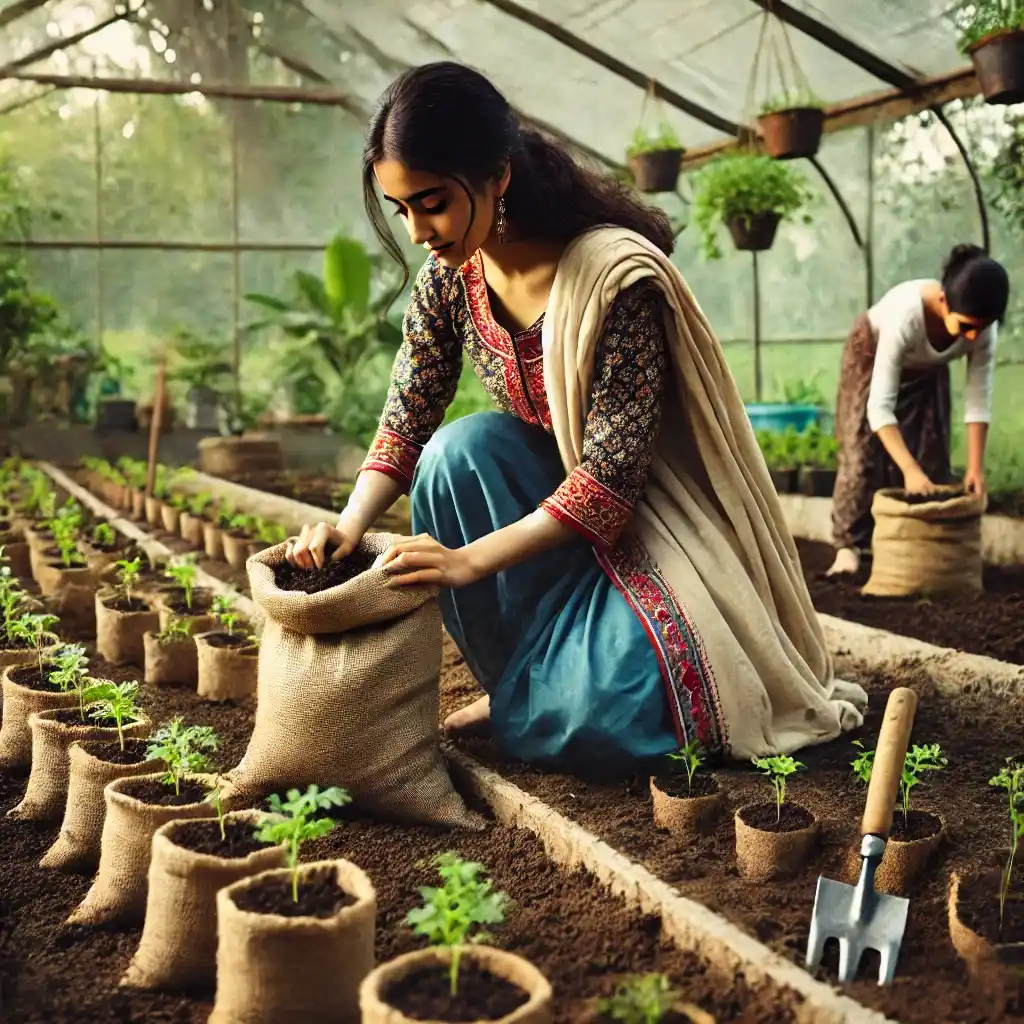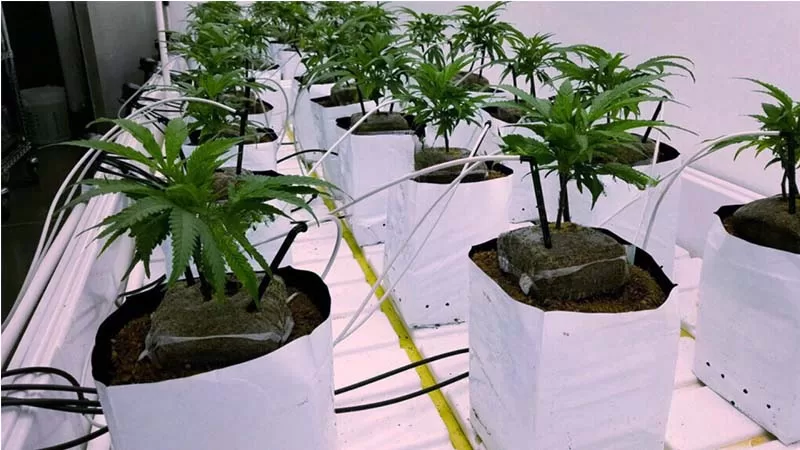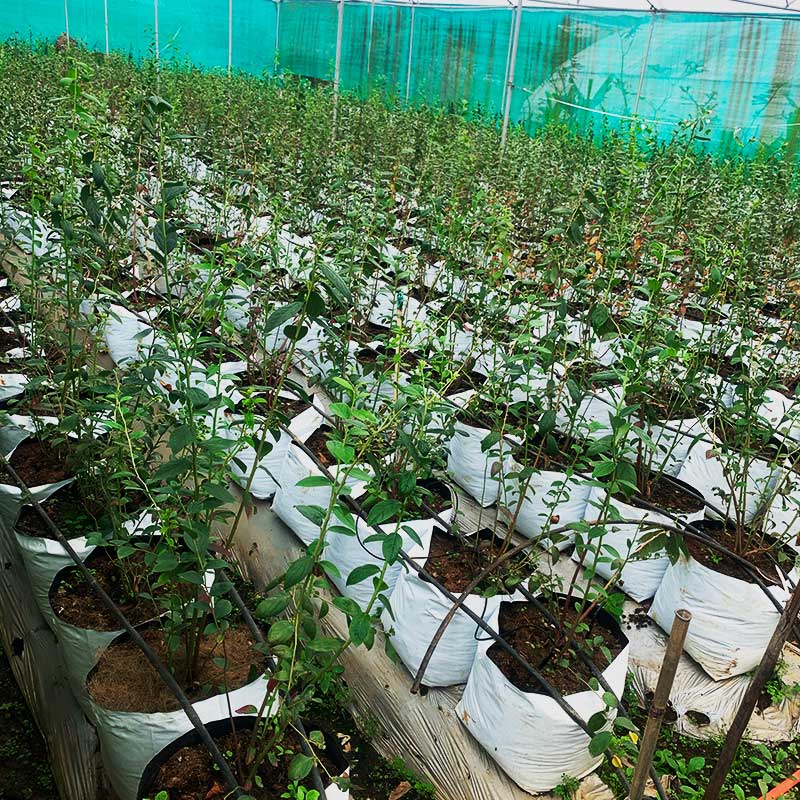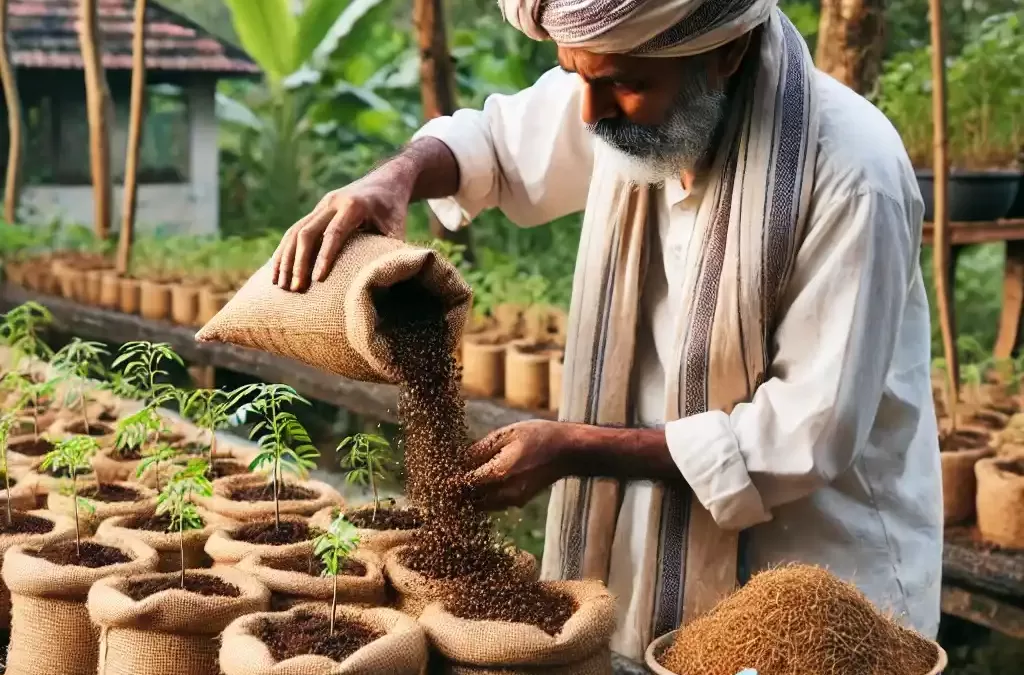Coir pith grow bags for agriculture
Coir pith grow bags are revolutionizing sustainable agriculture by offering an eco-friendly and highly efficient growing medium. These grow bags, made from coconut husk-derived coir pith, reduce the environmental impact of traditional soil-based farming while improving plant growth and soil health. Their natural water retention properties reduce irrigation needs, making them ideal for arid regions and water conservation efforts. Additionally, coir pith is biodegradable and replenishable, making it an excellent alternative to peat moss. By using coir pith grow bags, farmers can practice sustainable agriculture without depleting natural resources.
They are useful for hydroponic farming, organic agriculture, and greenhouse cultivation. Here’s how to use them effectively in sustainable farming:
Step-by-Step Guide to Using Coir Pith Grow Bags for Maximum Crop Growth
Choosing the Right gardening bags
Selecting the right gardening bags is crucial for ensuring optimal plant growth, efficient water management, and long-term sustainability. Here’s a deep dive into the key factors to consider when choosing coir pith grow bags:
- Different crops have varying root structures and space requirements, so selecting the correct size and depth is important.
- For leafy greens (lettuce, spinach, kale), choose smaller grow bags (25 cm x 20 cm x 20 cm), which support shallow root systems.
- For larger crops like tomatoes, cucumbers, and peppers, opt for larger bags (30 cm x 25 cm x 30 cm) to provide ample root expansion.
- Hydroponic and greenhouse growers often require customized bag sizes based on their specific system setups.
- Ensuring Proper Drainage and Dripper Holes
- Why Drainage is Important: Proper drainage prevents excess water retention, which can cause root rot and fungal diseases.
- Grow bags should include strategically placed drain holes to maintain a balance between moisture retention and aeration.
- Recommended Drainage Configurations:
- Standard grow bags: Pre-drilled bottom drain holes for soil-based cultivation.
- Hydroponic grow bags: Include dripper holes at the top for controlled water supply and bottom holes for excess water drainage.
- Custom drainage options: Some suppliers offer adjustable drainage options to meet specific moisture requirements.
- Opting for High-Quality, Organic-Certified Coir Pith Grow Bags
- Coir pith grow bags should be free from chemical contaminants that can harm plant growth and reduce soil health.
- What to Look For:
- Low EC (Electrical Conductivity) Coir Pith: Ensures minimal salt content, making it ideal for sensitive crops.
- Buffered Coir Pith: Pre-treated to remove excess sodium and potassium for improved nutrient absorption.
- Organic Certifications: Ensure that the coir grow bags meet standards like USDA Organic, OMRI-listed, or EU Organic Certification for chemical-free farming.
- Choosing high-quality, compressed coir grow bags helps ensure durability, preventing breakage and allowing for multiple crop cycles.
Preparing the Grow Bags for Planting
Proper preparation of coir pith grow bags is crucial for ensuring optimal plant health and nutrient absorption. Follow these steps to prepare your grow bags before planting:
- Hydrate the Coir Pith: Since coir pith is naturally compressed, it must be soaked in clean, pH-neutral water for six to eight hours to fully expand and achieve the right texture. Use filtered or rainwater instead of hard tap water to prevent introducing unwanted salts or chemicals.
- Draining Excess Water: Once the coir pith is hydrated, allow excess water to drain completely. Over-saturated coir can lead to waterlogging, reducing aeration and potentially leading to root rot. Let the water drain naturally by placing the bags on a sloped surface or perforated trays for at least 1–2 hours before planting.
- Buffering with Calcium Nitrate (If Required): Coir pith naturally contains sodium and potassium salts, which can interfere with nutrient uptake. Buffering with calcium nitrate (Ca(NO₃)₂) or calcium chloride helps remove excess sodium while stabilizing the pH between 5.5 and 6.5, which is ideal for most plants. To buffer the coir:
- Dissolve 50–100 grams of calcium nitrate per liter of water in a large container.
- Submerge the hydrated coir in this solution and let it soak for 4–6 hours.
- Drain the coir thoroughly and rinse with fresh water to remove excess calcium nitrate.
This step is especially important for hydroponic and greenhouse crops that require precise nutrient control. Proper buffering enhances calcium availability in the medium, preventing common deficiencies in plants like tomatoes, peppers, and leafy greens.
Once the coir pith grow bags are fully prepared, they are ready for planting and will provide an optimal balance of aeration, drainage, and moisture retention to support healthy crop growth.
Planting
Once the gardening bags are properly prepared, the planting process requires careful placement of seedlings, proper spacing, and optimal environmental conditions for healthy growth.
- Making Planting Holes
- Use a small gardening tool or your hands to create holes in the top layer of the bag. The hole depth should match the root system of the plant. For small herbs and leafy greens, a hole 2–3 cm deep is sufficient, while for larger vegetables like tomatoes and peppers, dig a 5–7 cm deep hole.
- Space out the holes evenly to prevent overcrowding and competition for nutrients.
- Spacing for Larger Plants
- Proper spacing ensures unrestricted root expansion, reducing stress on the plant and improving nutrient uptake. The recommended spacing for various crops includes:
- Leafy greens (lettuce, spinach, arugula): 10–15 cm apart
- Tomatoes and peppers: 30–40 cm apart
- Cucumbers and melons: 40–50 cm apart
- Overcrowded plants may experience stunted growth and lower yield, so ensure adequate space within each grow bag.
- Positioning Grow Bags for Optimal Growth
- Grow bags should be placed in a well-ventilated area with proper air circulation to prevent mold and fungal infections.
- Ensure they receive sufficient sunlight based on crop needs:
- Full-sun plants (tomatoes, peppers, cucumbers): 6–8 hours of sunlight daily.
- Partial-shade crops (lettuce, spinach, herbs): 4–6 hours of sunlight.
- If using grow bags in a greenhouse, arrange them in rows with pathways to facilitate easy watering and maintenance.
Watering and Irrigation
- Using a Drip Irrigation System
- Drip irrigation is the most efficient watering method for coco fiber gardening bags. It delivers water directly to the root zone, minimizing evaporation and preventing water waste.
- A well-calibrated system ensures a steady supply of moisture while avoiding overwatering.
- For hydroponic systems, automated drip irrigation helps maintain consistency in moisture levels.
- Monitoring Moisture Levels
- Overwatering or underwatering can stress plants and reduce yields. Regular monitoring is crucial for maintaining ideal moisture balance.
- Use a moisture meter to check soil dampness before watering. If the top 2–3 cm of coir feels dry, it’s time to water.
- Adjust watering schedules based on crop needs, climate, and humidity levels.
- Adjusting Watering Frequency
- Since coir retains significant moisture, watering once every 2–3 days is sufficient for most crops.
- In hot, dry climates, monitor evaporation rates and adjust irrigation accordingly.
- In humid environments, excess moisture retention may lead to fungal growth, so drainage must be optimized.
Nutrient Management
Coir pith is an inert growing medium, meaning it does not contain the essential nutrients required for plant growth. To maximize crop yield and health, proper nutrient enrichment and monitoring are necessary. Below are the key considerations for managing nutrients in coir pith grow bags:
Enriching Coir Pith with Organic Matter and Fertilizers
- Organic Compost: Adding composted manure, vermicompost, or kitchen compost improves microbial activity and releases essential nutrients like nitrogen (N), phosphorus (P), and potassium (K) slowly over time.
- Biofertilizers: Using beneficial bacteria and fungi (such as mycorrhizae, nitrogen-fixing bacteria, and phosphorus-solubilizing bacteria) helps improve nutrient uptake and promotes plant resilience.
- Liquid Nutrients: For hydroponic or soilless farming, water-soluble fertilizers like calcium nitrate, magnesium sulfate, and potassium nitrate should be added through the irrigation system.
Maintaining a Balanced Nutrient Supply
Proper nutrient balance ensures healthy growth and prevents nutrient deficiencies or toxic buildup. A recommended nutrient schedule for coir pith grow bags includes:
- Nitrogen (N): Promotes leafy growth and is essential for vegetables like lettuce and spinach.
- Phosphorus (P): Supports root development and flowering; critical for tomatoes, peppers, and fruiting crops.
- Potassium (K): Enhances fruit production and disease resistance, ideal for strawberries, cucumbers, and melons.
- Micronutrients: Include calcium (Ca), magnesium (Mg), sulfur (S), iron (Fe), zinc (Zn), and boron (B) to support overall plant metabolism.
Monitoring Electrical Conductivity (EC) and pH Levels
- Why EC Matters: Electrical Conductivity (EC) measures the total dissolved salts in the growing medium, indicating nutrient concentration. The ideal EC range for coir pith grow bags is 1.0 – 2.5 mS/cm, depending on the crop.
- Low EC (<1.0 mS/cm): Indicates insufficient nutrients, requiring fertilizer supplementation.
- High EC (>2.5 mS/cm): Suggests salt buildup, which can harm plant roots and requires flushing with clean water.
- Why pH Balance is Important: Coir pith naturally has a pH of 5.5 – 6.5, which is ideal for most plants. Maintaining the correct pH ensures efficient nutrient absorption.
- If pH is too acidic (<5.5): Add dolomite lime to increase alkalinity.
- If pH is too alkaline (>6.5): Use sulfur or acidic fertilizers to lower pH.
Nutrient Application Methods
- Drip Irrigation Fertigation: For controlled, gradual nutrient delivery directly to plant roots.
- Foliar Feeding: Spraying liquid nutrients on plant leaves for fast absorption.
- Top-Dressing: Adding dry organic fertilizers on top of the coir pith for slow-release nourishment.

Expert Tips to Reuse and Maintain Coir Substrate Bags for Multiple Crop Cycles
One of the biggest advantages of Coir Substrate Bags is their reusability, making them a cost-effective and sustainable solution for long-term farming. To ensure their effectiveness across multiple crop cycles, proper cleaning, maintenance, and strategic farming techniques should be followed.
Reuse Gardening Bags for Multiple Crops
After each harvest, coir pith grow bags should be cleaned and reconditioned before being reused for the next planting cycle. Follow these steps to ensure their longevity:
- Remove Old Plant Matter and Roots: After harvest, gently pull out old roots and plant debris to prevent disease build-up and ensure fresh root penetration in the next cycle.
- Sterilize the Grow Bags:
- Use hot water, steam sterilization, or organic disinfectants like hydrogen peroxide or diluted vinegar to eliminate any pathogens.
- If using chemical sterilization, allow the coir pith to dry fully before replanting to avoid any plant stress.
- Rehydrate and Replenish Nutrients:
- Rehydrating the coir pith is essential to restore its water retention capacity.
- Add organic compost, biofertilizers, or a controlled-release nutrient mix to improve soil fertility before the next crop cycle.
- Check for Structural Integrity: Inspect the bags for any tears or weak spots. If they are significantly damaged, repurpose them as mulch or soil amendments instead of discarding them.
Pair with Companion Planting
Companion planting in coir pith grow bags enhances biodiversity, naturally repels pests, and maximizes crop yields. Some strategic companion planting techniques include:
- Marigolds with Tomatoes: Marigolds repel nematodes and harmful insects, reducing the need for chemical pesticides.
- Basil with Peppers and Tomatoes: Improves flavor and deters aphids and hornworms.
- Carrots and Onions: Onions deter carrot flies, while carrots help aerate the coir pith medium.
- Beans with Corn: Beans fix nitrogen in the coir, improving soil fertility for corn.
By implementing companion planting, farmers reduce the reliance on synthetic pesticides and improve overall crop health.
Use Organic Pest Control
Since Coir Substrate is a sterile medium, it is naturally resistant to many soil-borne pests. However, pests can still invade plants growing in the medium. Using organic pest control methods helps maintain a chemical-free, eco-friendly growing environment.
- Neem Oil Spray: Acts as a natural insect repellent against aphids, whiteflies, and spider mites.
- Beneficial Insects: Introducing ladybugs and predatory wasps helps control pests naturally.
- Diatomaceous Earth: Sprinkling this powder on the surface deters soft-bodied insects.
- Organic Fungicides: A diluted baking soda or chamomile tea spray prevents fungal diseases.
By using biological and organic controls, farmers can maintain pest-free Coir Substrate Bags without compromising plant health.
Ensure Proper Drainage
Good drainage is critical for preventing root rot and promoting healthy root development. Follow these best practices:
- Elevate: Place them on wooden pallets, raised beds, or shelving units to allow excess water to drain freely.
- Monitor Drainage Holes: Ensure they remain unclogged to prevent water stagnation.
- Use Drip Trays or Catchment Systems: For hydroponic setups, collect excess runoff to reuse water efficiently.
Proper drainage prevents waterlogged roots and fungal diseases, ensuring plants receive the right balance of moisture and aeration.
Store Properly
When not in use, storing coir substrate bags properly helps maintain their structure, usability, and longevity.
- Keep in a Dry, Ventilated Area: Moisture buildup in stored grow bags can lead to mold or microbial growth.
- Avoid Direct Sunlight: UV exposure can weaken the bag material over time, reducing its durability.
- Stack Properly: Store in an organized manner to prevent bag deformation and unnecessary damage.
- Cover with a Tarp or Plastic Wrap: Protects from dust, pests, and environmental wear-and-tear.
By following proper storage practices, coir fiber grow bags can be reused for multiple growing seasons without compromising quality.
coir fiber gardening bags are a cost-effective, sustainable, and high-yield farming solution. Their ability to be reused across multiple crop cycles makes them an economical choice for commercial and small-scale farmers. By following best practices in cleaning, companion planting, organic pest control, drainage management, and storage, growers can maximize the lifespan and efficiency of their grow bags while contributing to sustainable agriculture.
As the demand for eco-friendly farming solutions increases, the proper maintenance and reuse of coir pith grow bags will play a vital role in reducing agricultural waste, conserving resources, and ensuring long-term farming success.

Why Coir Pith Grow Bags Are a Key to Sustainable Farming
- Water Conservation: Reduces irrigation by up to 30% due to excellent water retention.
- Soil Health Improvement: Prevents soil depletion and enhances aeration.
- Eco-Friendly Alternative: 100% biodegradable and a sustainable replacement for peat moss.
- Higher Crop Yields: Provides better root development and nutrient absorption compared to traditional soil.
Using coir pith grow bags in sustainable agriculture helps conserve water, improve plant growth, and reduce environmental damage. They are ideal for organic and commercial farming, ensuring efficient resource use while maintaining soil fertility. With proper management and care, these grow bags can be a game-changer in modern eco-friendly agriculture.
Impact of Coir Pith Grow Bags in Sustainable Farming
|
Parameter |
Coir Pith Grow Bags |
Traditional Soil-Based Farming |
|
Water Retention Capacity |
8-10 times its weight |
2-4 times its weight |
|
Reduction in Water Usage |
Up to 30% |
High water consumption |
|
Greenhouse Gas Emissions |
Low |
High (peat moss extraction) |
|
Fertilizer Efficiency |
25% less fertilizer runoff |
Higher leaching of nutrients |
|
Biodegradability |
100% biodegradable |
Soil degradation over time |
|
Crop Yield Increase |
Up to 40% in greenhouses |
Standard yield rates |
Coir pith grow bags are revolutionizing sustainable agriculture by providing an eco-friendly, resource-efficient, and highly productive growing medium. Their superior water retention, aeration, and drainage properties make them a viable alternative to traditional soil-based farming, particularly in regions facing water scarcity and soil degradation. By enabling optimal
nutrient management, reducing irrigation needs, and supporting organic cultivation, these grow bags contribute significantly to environmental conservation and food security.
Farmers, greenhouse growers, and hydroponic cultivators worldwide are adopting coir pith grow bags due to their cost-effectiveness, biodegradability, and ability to improve crop yields. The shift towards sustainable farming practices underscores the importance of choosing high-quality coir pith grow bags, ensuring proper nutrient enrichment, efficient irrigation, and effective crop management.
As demand for sustainable agriculture grows, coir pith grow bags stand out as a practical and scalable solution for modern farming. By integrating them into farming systems, growers can reduce environmental impact while achieving high-yield, high-quality crop production. The future of agriculture lies in sustainable innovations, and coir pith grow bags are paving the way for a more resilient and eco-friendly farming approach.


